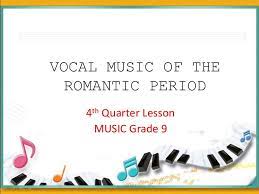
MUSIC 9-QUARTER 4
Music is both an aural and a temporal art. All its elements, when interwoven in the highest artistic order, are likened into a -- tapestry moving in time.
The global weavings of this tapestry in historical and cultural contexts are diverse -- having spurred a continued metamorphosis to include a full range of
purposes, functions, and identities, from the utilitarian to aesthetic.
However, the basic nature of music does not change. In his book A Structure for Music Education, Ronald Thomas articulates that the nature of music is
expressive, ongoing, and creative. Through a language and medium of its own, music conveys ideas and feelings in a way that addresses the human spirit, and
has great value in its communicative process. Music, being responsive in interpreting contemporary times, is a continuing art. Aaron Copland describes this
characteristic as a continuous state of becoming. Like the other arts, music is a creative avenue for man’s individual quest for self- expression and fulfillment.
On these basic characteristics are founded the rationale of music study. A keen sensitivity to environmental and musical sounds needs to be
developed. The student must learn to ―hear, ―speak, and ―think in the medium of music. Simultaneously, growth and development in the skills that enable the
application of the learner’s knowledge should be encouraged, through active involvement in the various musical processes.
Drawing from the development of music pedagogy through the years, the K-10 Music Curriculum embodies the best practices advocated by the
SPIRAL, MULTI-CULTURAL, and INTEGRATIVE approaches in music education, as well as current philosophical thought about contemporary general
education.
We envision that Music in the K-10 Program will effectively nurture and refine the learner’s artistic expression and cultural literacy, and celebrate his/her
national heritage, while it instills, within every individual Filipino learner, pride in his/her own cultural identity.
The learner demonstrates understanding of salient features of Western music and the arts from different historical periods, through appreciation, analysis,
and performance for self-development, the celebration of Filipino cultural identity and diversity, and the expansion of one’s world vision.

